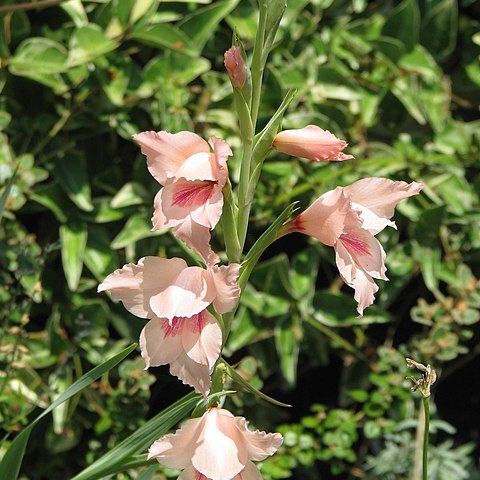Plants (300-)400-600 mm high. Corm depressed-globose, (20-)30-50 mm diam.; tunics papery, with numerous small cormlets. Stem erect, unbranched. Leaves 7 to 9, mostly basal in a fan reaching to base of spike or exceeding it, lanceolate, 15-25 mm wide, main vein strongly thickened, margins usually less so, 1 or more secondary vein pairs also usually prominent, cauline leaves usually sheathing stem to base of spike. Spike erect to slightly inclined, ± straight, (2)4-to 9-flowered; bracts green, apices twisted, outer 40-60(-70) mm long, lightly folded in midline, inner bracts slightly shorter, forked into linear cusps. Flowers facing sideways or drooping, bright red, lower 3 tepals lightly to densely speckled in lower half with red on a white field, unscented; perianth tube obliquely funnel-shaped, 33-37 mm long; tepals lanceolate, unequal, upper 3 largest, 46-67 x 21-30 mm, dorsal extending horizontally or tilted downward over stamens, recurving distally, upper laterals curving outward from base, lower 3 tepals joined to upper laterals for ± 6 mm, and together for ± 2 mm, arching downward, recurved distally, somewhat smaller than upper, lower laterals 34-46 mm long, lower median 46-53 x 20-28 mm. Filaments 30-50 mm long, exserted 20-30 mm from tube; anthers 15-16 mm long, apiculate, tilted downward, purple; pollen cream-coloured. Style arching over stamens, dividing between middle and upper 1/3 of anthers, branches 7-8 mm long. Capsules oblong-obovate, 3-lobed above and retuse, 25-28 mm long. Seeds ovate, ± 6.5 x 8.5 mm, broadly and evenly winged.
More
Perennial herb, geophyte, 0.4-0.7 m high; corm depressed-globose, tunics of dry papery layers, bearing many purplish brown cormlets; stem erect, simple. Leaves 7-9, lanceolate, 15-25 mm wide, midrib strongly thickened, margins slightly thickened. Bracts green, lightly folded in midline, apex twisted, sometimes forked into linear cusps. Inflorescence a 2-9-flowered spike, erect or lightly inclined; flowers bright red, facing sideways or drooping; perianth tube obliquely funnel-shaped; tepals lanceolate, unequal, 3 upper largest, the dorsal extending horizontally or tilted downward over stamens. Stamens exserted; anthers purple, with minute apiculus; pollen cream-coloured. Ovary oblong; style arching over stamens. Flowering time Dec.-Mar. Capsule oblong-obovoid, 3-lobed, retuse apically.
Cormous geophyte, up to 0.6 m high, in colonies. Leaves firm, erect, in a fan, 15-25 mm wide, midrib thickened, veins prominent. Flowers: in a 4-9-flowered, erect spike; ± 60 mm wide, downward facing, strongly hooded; anthers 15-16 mm long, purple; perianth bright red with broad white mark and speckling on 3 lower segments; Jan.-Mar.

